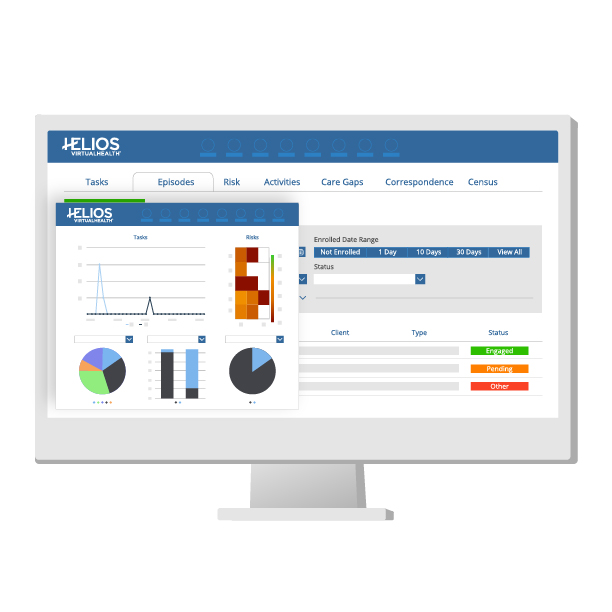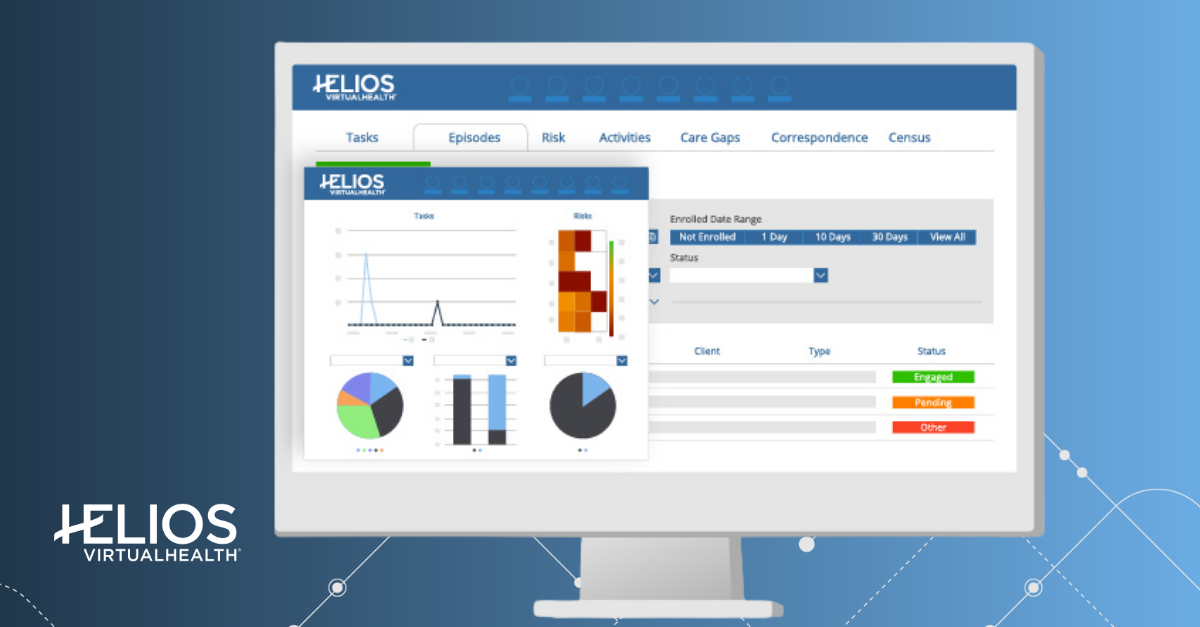We’re in the age of big data, and one of the challenges healthcare payers have is to make sense of all the data they capture. From pulling actionable insights to identify and close care gaps to quickly providing the quality metrics and reports needed by state and federal regulatory bodies.
For healthcare organizations, integrating data-driven insights into clinical and operational processes can help drive better health outcomes, make care teams more effective and efficient, lower healthcare costs through proactive care, and create better visibility into performance and productivity.
Below we look at six ways healthcare payors and plans can improve data and analytics initiatives this year, including how to use insights to improve workflows, and we offer a quick resource if you want to learn more about reporting and analytics from VirtualHealth and in HELIOS.
1. Use Insights to Improve CM/UM Workflows
In today’s data-rich landscape, healthcare payers are navigating the vast seas of information, striving to distill actionable insights from the deluge. This pursuit is not merely about harnessing data for its own sake but about leveraging it to illuminate and bridge care gaps, streamline reporting processes, and satisfy the stringent demands of care management (CM) and utilization management (UM).
For the sake of this section, we’ll look at how this transformative journey begins with a dynamic, data-informed strategy encapsulated within the HELIOS platform. At VirtualHealth, this framework is structured around a cyclical, three-phase feedback loop that ensures continuous improvement and adaptation to the evolving needs of CM/UM delivery.

- Phase 1: Configure Workflow in HELIOS – At the outset, clients help sculpt the HELIOS platform to mirror their desired workflow processes via HELIOS configurations. This critical initial step allows for the bespoke tailoring of HELIOS to capture and manage data in a way that aligns with client-specific operational goals and healthcare delivery models.
- Phase 2: Implement Workflow in HELIOS – With the configurations set, the real magic happens. Clinical managers, administrators, providers, and other stakeholders engage with the HELIOS portals to execute the CM/UM workflows. This phase is where the rubber meets the road—operationalizing the CM/DM strategies and processes that were meticulously planned in the first phase.
- Phase 3: Understand Workflow Effectiveness – The final phase in the loop is reflective and analytical. Clients harness the power of HELIOS to generate insights and gauge the effectiveness of their CM/UM workflows. This step is crucial for understanding outcomes, identifying areas for improvement, and ensuring that the workflows drive better health outcomes, enhance care team efficiency, and lower healthcare costs through proactive care measures.
Then, the cycle recommences. Armed with new insights and a deeper understanding of workflow effectiveness, VirtualHealth HELIOS clients can revisit the configuration phase to refine and optimize their processes. This iterative loop fosters a culture of continuous improvement and allows clients to adapt HELIOS to evolving care models. Moreover, this enables data-driven strategies to be intricately woven into the fabric of clinical and operational practices. By doing so, HELIOS clients not only achieve better visibility into performance and productivity but also catalyze transformative changes that drive superior health outcomes and operational excellence.
2. Data Collection & Cleaning
Healthcare data comes from a variety of sources. Provider systems, state-specific organization or program databases, remote patient monitoring devices, EHRs, EMRs, and more. The issue is that capturing all this disparate data in a clean, complete, accurate, and properly formatted way is an ongoing battle.
This lack of data uniformity also compounds existing interoperability issues. To help with this, healthcare payors should look to capture data more directly (at the point of origin) via intelligent interfaces and integrations. HELIOS, for example, interfaces with hundreds of systems to enable comprehensive data capture.
After collection, data cleaning is critical. This includes mapping, formatting, validation, and transformation to ensure the consumed data points can be properly leveraged.
How VirtualHealth Handles Data Migration
VirtualHealth’s HELIOS platform is one of the most interoperable solutions in the market and presently exchanges tens of millions of records daily across multiple systems and formats, including enrollment and eligibility data, clinical summaries, medical claims, pharmacy data, lab results, provider and network information, medical and LTSS authorizations, assessments, service plans, risk metrics, and records for delegated entities, among others. HELIOS can interface with hundreds of systems and offers the broadest spectrum of interfaces, including support for standard, real-time, HL7 two-way interfaces.
VirtualHealth has also integrated with hundreds of systems, including specific systems such as SAP and Oracle, EMRs such as eClinicalWorks and SigmaCare, HIEs, ePA networks, and state Medicaid exchanges, among others. VirtualHealth’s proprietary data integration process also assures the development of proper business rules for the data consumption process and ensures that incoming data is mapped to the appropriate member record and the appropriate overwrite rules are observed.
3. Use an Integrated Interoperability Solution for 65% Faster Data Integrations & FHIR® ® Compatibility:
Another way to enhance data and analytics this year is to use a single source of truth for data integration and management. VirtualHealth’s data interoperability application – HELIOShub – offers an ideal solution for this.
A secure and integrated FHIR® integration platform as a service, HELIOShub helps payers to quickly transform data into FHIR-compatible formats and works with both existing and new data architectures. HELIOShub lets you connect and transform all critical data into formats that meet the HL7® FHIR® standard, without either specialization or heavy lifting by IT teams.
Configurable data transformations, mapping, and transfer methods translate to faster delivery, rapid time to market, and reduced implementation and maintenance costs.
This data interoperability FHIR® solution can help healthcare payers to:
- Achieve data interoperability
- Meet new regulatory requirements around FHIR® APIs
- Enable data uniformity faster
- Centralize enterprise data management initiatives
- Gain more accurate and comprehensive analytics and insights
HELIOShub also gives you a FHIR® store for leading implementation guides, real-time bi-directional integration flows, unlimited application connections, a comprehensive library of APIs for managing import/export operations, and more. Learn more about HELIOShub here >
4. Data Storage and Accessibility
Making sure data is cost-effectively managed as well is key. HELIOS as a HIPAA-compliant cloud-based solution is easily able to manage high volumes of data capture, even as health plans expand membership over time. This enables cost-effective data storage and management and scalability, while also ensuring robust security and disaster recovery.
Data from HELIOS is also easily accessible and can be accessed in multiple formats. This ensures compatibility with clients’ connected systems and solutions and reporting tools such as Power BI.
HELIOS users can access data in a variety of ways including dashboards, views, reporting modalities, excel downloads, and a query-able replicated database. Moreover, HELIOS integrates with business intelligence tools (Power BI, Tableau, etc.) through robust analytics and reporting APIs for even more enhanced data and analytics.
5. Leverage Comprehensive Healthcare Management Reporting Tools
HELIOS supports a wide array of data views, dashboards, and reporting modalities that are essential for operational, compliance, and quality assurance purposes. The platform supports diverse views, native dashboards, views, and reporting modalities out-of-the-box, with detailed analytics and visuals, as well as configurable elements.
This helps HELIOS clients fulfill a wide range of reporting tasks essential for operations, compliance, and quality assurance. The platform provides a dedicated reporting section where users can select the desired custom type and generate the corresponding report, which is then available for both in-platform view and Excel download.
HELIOS provides detailed insights into user interactions, care management outcomes, and program efficiencies through standard, configurable, and custom reports. Reports can be generated based on quality, quantity, and productive variances. Users can export and save reports in multiple formats, and a broad range of standard reports, views, and dashboards are supported.

Measuring Critical Outcomes: HEDIS, ODAG & More
HELIOS offers advanced analytics and reporting for measuring outcomes, whether in the form of HEDIS measures, ODAG/CDAG reporting, vitals or biometric data, care goal completion or progress, changes in behavior frequency or intensity, increases or decreases in medication number of dosage, changes in social or clinical services administered, vaccinations received, or other metrics.
Download our HELIOS Reporting Information brochure to learn more about this >
6. Work with Data and Analytics Experts
In addition to the powerful reporting and analytics capabilities in the platform, VirtualHealth also offers Analytics as a Service. This is a unique offering that helps clients to accelerate and support their data and reporting needs. Clients scope the service requirements they need, working directly with VirtualHealth’s team of experts to develop custom reports or dashboards and to complete specific queries.
Key services provided:
- SQL Support (HELIOS Scripting Support in Most SQL Dialects)
- Schema / Data Transformation Requests
- Custom Queries or Reports
- Custom Dashboards / Dashboard & Development Support
- Dedicated Ad Hoc SQL & HELIOS Database Schema Training
- And more!
Ask our team about VirtualHealth’s Analytics as a Service >

